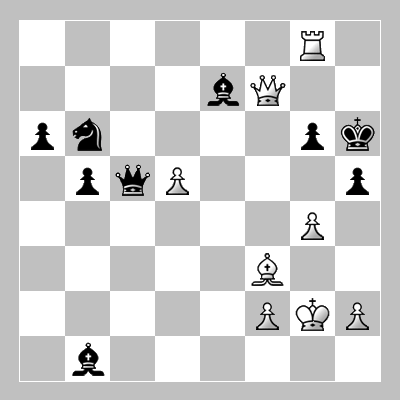In 1979, in a category IX tournament (average elo rating 2451-2475) held in (the then) Yugoslavia, there were 16 players. There was one player who was 16 year old and did not even have any FIDE rating in a field of 14 Grandmasters (including a former World Champion) and one IM. Reportedly, a mistake on the part of Russian Chess Federation (they thought it was a junior tournament!) enabled him to participate (or were they trying to groom him in an underhand way?)
Whatever may be the truth, that player did not lose a single game winning 8 and drawing 7 and won the tournament with a lead of 2 points over the player who came second. This was the first Grandmaster norm for the player as he earned a rating of 2595! I read about this in a syndicated column of Michael Stean in a sports magazine of those times and he predicted World Championship for that young player. Garry Kasparov vindicated him by winning the world championship six years later in 1985.
How far deep can you analyze?
Unlike what you may think, even players of GM caliber are said to go only about 4-5 moves deep in middle games. With a still crowded board, the sheer number of possibilities go beyond the capability of human brain. In end game it is different as there are not many pieces and only a handful may be active in a position.
With this background, you will definitely find it very interesting to play through the moves of the 1956 game between Bobby Fischer and Donald Byrne (available at many sites). Fischer was a 12 year old kid and was playing with Black pieces. Byrne was 26 year old and had won the US championhip three years earlier. By his 17th move, Fischer offered his queen to White to get two minor pieces in exchange and a good attack! But the point of his queen sacrifice became clear with his 24th move, after which Fischer gained decisive material compensation. A few moves later, it was apparent that White had a losing position and could as well resign. But Byrne played on quite sportingly to allow the kid the satisfaction of delivering a checkmate, which Fischer did on move 41. You will not find Byrne making any serious error but the way Black played between his 17th and 24th moves, we are bound to think that Fischer had seen to a depth of 7 moves!
Is this how chess games are won?
If you ever feel miserable after losing a game through your blunder, please don’t and take heart that you may be in a very enviable company! Samuel Reshevsky was a child prodigy, a US champion, a Grandmaster in 1950, a strong contender for world championship and author of several books including “How Chess Games Are Won”! In 1973, he had a game as White against Vladimir Savon who became a GM in 1971 and was never a contender for World Championship. Just take a look at the board position after 39 moves.

The following set of moves gives White a forced win.
| 40. |
g5+ |
Kxg5 |
|
40. … Bxg5 allows 41. Rh8#
|
| 41. |
h4+ |
Kxh4 |
|
41. … Kh6 allows 42. Rh8# |
| 42. |
Qf4# |
|
|
|
What does Reshevsky do? He played 40. Qxg6+?? and Black gratefully accepted the queen by 40. … Bxg6. What a way to lose a winning position!
Is this how world champions adopt winning strategy?
Take a look at the 1993 game Karpov played as Black against Christiansen. The game went:
| 1. |
d4 |
Nf6 |
|
|
| 2. |
c4 |
e6 |
|
|
| 3. |
Nf3 |
b6 |
|
|
| 4. |
a3 |
Ba6 |
|
|
| 5. |
Qc2 |
Bb7 |
|
|
| 6. |
Nc3 |
c5 |
|
|
| 7. |
e4 |
cxd4 |
|
|
| 8. |
Nxd4 |
Nc6 |
|
|
| 9. |
Nxc6 |
Bxc6 |
|
|
| 10. |
Bf4 |
Nh5 |
|
|
| 11. |
Be3 |
|
|
|
Position after 11. Be3:

| 11. |
… |
Bd6?? |
|
|
| 12. |
Qd1 |
Resigns |
|
|
Black cannot avoid losing either the bishop or the knight getting only a pawn in exchange. Karpov must have felt disgusted with himself and resigned forthwith.
How many violations did Karpov make regarding the winning strategies we discussed? Losing tempo by moving same piece twice, retarded pawn development, backward Queens pawn blocked by an unsupported bishop, knight placed on the edge of board, no coordination among pieces …



